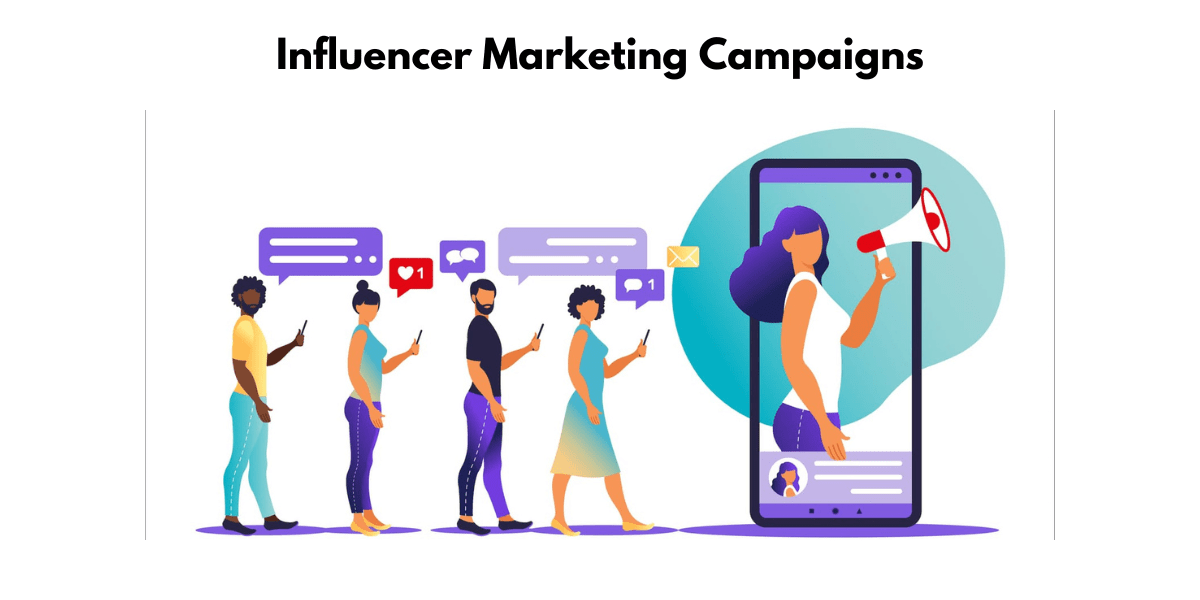The Ultimate Guide to Influencer Marketing Campaigns: 10 things you need to know
What is influencer marketing?
Influencer marketing is a social media marketing strategy involving brands partnering with influencers.
Influencers are trusted content creators with the power to affect how their audience makes purchasing decisions and have a large, well-engaged following in their niche.
Influencers can endorse products, make product mentions, and share their opinions with their audience.
Brands find influencers on Instagram and other social media platforms which are a good fit and partner with them to raise brand awareness and boost sales and leads.
By partnering with influencers, brands get exposure and sales, influencers get paid, and their followers get the motivation to buy products and services recommended by their favorite content creators.
Is marketing with influencers effective?
There is no doubt that influencer marketing has become one of the most popular and effective digital marketing strategies in the last few years.
A recent study showed that 94% of marketers across various industries believe influencer marketing is an effective campaign strategy.
This data supports the idea that influencer marketing is successful when implemented correctly.
In addition, research from Linqia found that 86% of women surveyed consult social media communities’ recommendations, while 72% make purchasing decisions frequently based on advice from those online social connections.
This indicates that people are influenced by social media influencers more than ever.
Business Insider’s Intelligence estimates that brands will spend up to $15 billion on influencer marketing campaigns by 2022.
This supports the idea that influencer marketing is a great return on investment for companies in the long run.
Overall, influencer marketing campaigns have proven to be an effective way for brands to connect with their audience, increase awareness and engagement, and generate sales.
To maximize results, it is important to be strategic and focused when creating influencer marketing campaigns.

The value of influencer media
The value of influencer marketing is undeniable.
According to social media influencer statistics, only 1% of millennials trust advertisements, but 33% trust blog reviews when purchasing.
When purchasing products online, around 40% of people will buy a product after seeing it used by an influencer on Instagram, Twitter, or YouTube.
This has led to influencer marketing campaigns that yield a $6.50 return on investment for every dollar spent.
The industry is estimated to be worth around $15 billion by 2022, and many brands are taking advantage of this marketing tool.
80% of marketers confirm the effectiveness of brand influencer marketing, and 35% find it extremely effective.
89% say influencer marketing’s ROI equals or exceeds other marketing platforms, and 71% of marketers believe that influencer partnerships are good for business.
Moreover, the most crucial influencer goal for brands is increasing brand awareness.
The most common budget for influencer campaigns is $1,000 – 10,000 per year per company, followed by $100,000 – 500,000 per year.
Overall, influencer marketing is a great way for brands to reach new audiences and generate sales/conversions, and it has a strong return on investment.
It is an incredibly popular marketing tool, and many brands exploit it.
Influencer marketing strategy
Today, brands and marketers have moved away from traditional marketing strategies such as TV and radio and adopted new digital marketing strategies better suited to modern times.
One of the most popular and effective of these is influencer marketing.
Through influencer marketing, a brand works with an influencer who has established a strong personal brand and built a loyal online following to promote their product, service, or brand.
According to the State of Influencer Marketing 2020 report, 94% of marketers believe influencer marketing effectively drives sales.
This guide will provide an overview of influencer marketing strategy and discuss how to create one. It will cover topics like researching and setting a budget, determining goals, finding influencers, and revising your strategy.
Additionally, resources for creating influencer campaigns will be provided. With this information, you should feel confident creating a successful influencer marketing strategy for your business.

1. Identify the right influencer
Identifying the right influencer for a successful influencer marketing campaign is crucial.
Finding the right influencer can be time-consuming and requires research and effort.
Defining the audience for a specific campaign and creating matching influencer personas to ensure that the influencers align with the brand’s goals is important.
Additionally, it is important to pay attention to the quality of the influencers’ followers, the content they post, and the reactions they receive to ensure that the influencer is a good fit for the brand’s campaign objectives.
Ultimately, by selecting the right influencer, a brand can increase the reach and impact of its campaign and elevate its brand reputation.
2. Develop a strategy
Developing an influencer marketing strategy to effectively reach a specific target audience and communicate a clear, consistent message is important.
Developing an influencer marketing strategy involves defining a target audience, creating matching influencer personas, setting goals and objectives, and determining a message.
By doing this, brands and marketers can ensure that their message is conveyed authentically and personally to an audience likely to be interested in their product.
This helps brands differentiate their content from traditional marketing techniques and allows them to skip trends and emphasize their brand values.
3. Estimate the cost
Engaging an influencer for marketing purposes can cost anywhere from nothing to millions of dollars, depending on the size and reach of the influencer.
The average cost per post for micro-influencers with fewer than 1,000 followers is $83.
The average cost per post for influencers with more than 100,000 followers is $763. U.S. spending on influencer marketing is set to surpass $3 billion in 2021, estimated to reach $4 billion by 2022.
It is important to research, think about the expected ROI of the campaign, and consider the influencer’s needs when creating a budget.
4. Find the right platforms
Finding the right platform for influencer marketing is important because it helps ensure that the campaign you create is successful and reaches your target audience.
By thoroughly analyzing the influencer’s platform’s demographics, you can tailor the content better and determine what type of content will reach the most people.
Additionally, by taking into account the goals of the influencer campaign, you can create content focused on achieving those goals.
By finding the right platform for your influencer marketing campaign, you can maximize the success of your efforts and ultimately get the most out of your campaign.

5. Engage the right team
Engaging the right marketing team in influencer marketing is vitally important, as the industry is constantly changing and evolving.
Brands must do their due diligence to ensure that their campaigns won’t go down the drain and that their influencer partnerships will be effective.
This means thoroughly analyzing the influencers’ metrics and audience quality, loyalty, and level of engagement before reaching an agreement with them.
Finding micro-influencers with an engaged audience is also key to success, allowing content creators to get to know the brand and its products.
Analyzing their audience’s reaction to sponsored content, tracking leads and sales, and ensuring content creators can speak to the brand’s target audience is essential to a successful campaign.
Ultimately, the key to success is to find content creators that the brand’s target audience trusts and respect.
6. Create the right content
Creating good content for influencer marketing requires taking a holistic approach.
Content should be not only informative but also emotionally resonant.
Blog posts, videos, and user-generated content (UGC) are all excellent options for creating engaging content.
- Blog posts can be used to build authority, generate interest in your products, and provide valuable information.
- Videos are incredibly popular and are great for showcasing products in a fun and relatable way.
- UGC can also be used to demonstrate trust and authenticity, as it often comes from customers that have already tried the product.
When creating content, be sure to have the plan to take full advantage of the content.
7. Find the right hashtag
Finding the right hashtag for your influencer marketing efforts is crucial for success.
Here’s a step-by-step guide to help you find the perfect hashtag for your campaign.
- Identify your goals: Before starting, think about what you hope to accomplish with your influencer marketing campaign. This will help you determine the right hashtag and ensure it fits your goals.
- Choose a specific hashtag: Pick a unique and specific hashtag for your campaign. Ensure it’s easy to remember, spell, and, most importantly, relevant to your target audience.
- Track your hashtag: Use Sprout Social’s Smart Inbox to track what your influencers say and share with your specific hashtag. This will help you gain insights into the effectiveness of your influencer marketing efforts.
- Monitor engagement: Monitor the engagement that your hashtag is receiving. This will give you an indication of the success of your influencer marketing campaign and also help you identify potential improvements.
- Test different hashtag variations: Test out different variations of your hashtag to see which resonates most with your target audience. This will help you refine your influencer marketing strategy and ensure you get the best results.
Following these five steps, you can easily find the perfect hashtag for your influencer marketing campaign.
With the right hashtag, you can maximize the reach of your influencers and amplify your brand’s message.
8. Plan for the right duration
How long should an influencer campaign last?
Timing and duration are important factors in running a successful influencer campaign.
Depending on the size and scope of the campaign, it can range from weeks to months.
However, it’s best to set pre-determined dates to measure the campaign’s progress.
This will give you a better idea of how well the campaign is doing and allow you to make any necessary changes.
Additionally, be sure to factor in time for planning, executing, and reviewing the campaign, as it can take longer than expected.

9. Understand the right type of relationship
The right type of relationship for influencer marketing is based on trust and respect.
Without these components, any results of your efforts will be superficial.
To gain trust and respect, you need to look at the influencer’s engagement rate.
A good engagement rate will ensure a loyal following, not just an inflated follower count.
You’ll also want to ensure the tone of their content and the look and feel of their posts are appropriate for how you want to present your brand.
Additionally, you want to ensure the influencer is a genuine fit for your brand.
You can use social listening tools to find influencers who genuinely are interested in your niche and can create content that complements your own.
Lastly, ensure the influencer loves your brand and has been promoting your products without a sponsorship.
By taking the time to understand the different types of influencers, you can make sure your relationship with them is the right one.
10. Evaluate the right results
It is important to evaluate influencer marketing results to assess how effective the partnership will be and choose the right strategy and platforms.
This is why thorough analytics should be done before, during, and after the campaign.
Evaluating influencer marketing results can also help brands determine if the influencers they chose can effectively speak to their target audience, ensure minimal overlap between multiple influencers, create brand ambassadors, and track leads and sales.
Analyzing the audience’s reaction to sponsored content, using analytics and specialized software, and using platforms like Unbox Social to get data-driven reports on their campaigns are all great ways to evaluate influencer marketing results.
10 facts about influencer marketing
Influencer marketing was once assumed to be a niche strategy reserved for celebrities and a few dedicated bloggers.
However, in the last decade, we’ve seen the rise of social media influencers and the power they can have on the success of a brand.
Navigating the social influencer marketing landscape can be daunting, so here are 10 facts that can help make sense of it all.

1. Influencer marketing is becoming increasingly popular
Influencer marketing is becoming increasingly popular among businesses of all sizes.
According to a survey from 2021, nearly nine out of ten brands are using some form of influencer marketing, making it one of the most popular forms of digital marketing.
Its worth is expected to grow from $13.8 billion in 2021 to $15 billion in 2022, and the use of influencer marketing among U.S. marketers is expected to increase from 67.9% to 72.5% in 2022.
Micro and nano influencers, who have significantly fewer followers than mega or celebrity influencers but have the highest engagement rates, are also gaining popularity.
There is also a greater focus on “authenticity” and brands opting for ongoing partnerships with influencers rather than a single sponsored post.
Additionally, the rise of TikTok has led to 68% of U.S. marketers planning to use it for influencer marketing.
Influencer marketing will become even bigger in the coming years, so now is the time to learn about it and incorporate it into your strategies.
It does not look like it will be fading away anytime soon, as its effectiveness is proven by the fact that it can generate an equivalent earned media value of $18 per $1 spent.
2. Influencers can help increase awareness and engagement for a brand
Influencer marketing can be an effective way to increase brand awareness and engagement.
By partnering with well-known people in the industry, brands can build trust, reach a niche market and create content that resonates more with their target audience.
Through influencers, brands can create content with a conversational tone, personal narrative, and more organic feel, which can help differentiate it from brand-created content.
Additionally, influencers make it easier for brands to connect with potential customers and tell their stories in their way.
Lastly, brands can use influencers to reach specific audiences and ensure their message is communicated accurately.
All these factors can help brands increase awareness and engagement for their products and services.
3. There are different types of influencers to consider when creating a campaign
When creating an influencer marketing campaign, there are a variety of influencers to consider, each with its advantages and disadvantages.
Nano-influencers have a smaller following, often in the 1,000 to 5,000 followers range.
They are great for creating an intimate and genuine connection with their followers and often have more engagement than larger influencers.
Micro-influencers have a larger following (up to 100,000 followers) and are great for creating content that can be widely used.
Macro-influencers and Mega-influencers are individuals with even larger followings, often millions, and great for creating highly visible and widely shared content.
No matter which type of influencer you choose, it is important to research and collaborate with experienced social media influencers who share your brand values.
This will ensure that your influencer marketing campaign is successful and reaches the maximum number of people.
4. Influencers can help drive sales for a brand
Influencer marketing can help brands drive sales by connecting them with their target audience and helping them build trust.
By partnering with well-known people in the industry, brands can reach a niche market and create content that outperforms brand-created content.
Influencers are experts in the field, so they can tell the brand’s story organically and provide direct links to the ecommerce store.
Furthermore, they can reach a specific audience and use a conversational tone and personal narrative to differentiate their posts from the brands.
Through influencer marketing, brands can increase brand awareness, boost conversions and drive sales.

5. Influencers can connect with their audience in a unique way
Influencers connect with their audience by first authentically engaging them on their active platforms.
This can be done by following them, sharing their content, commenting on their blogs, and engaging them in relevant conversations.
It’s important to establish a relationship of mutual trust with the influencer to engage them as brand advocates successfully.
Additionally, when creating campaigns, it’s important to ensure the influencer understands your brand’s voice and what it stands for.
When selecting a platform for the campaign, it’s important to consider where your audience is most active and what type of content performs best on each platform.
Lastly, empowering the influencer through access to the brand and information but not taking creative control will help ensure the campaign is successful.
6. Influencer marketing campaigns should be carefully planned
Influencer marketing campaigns should be carefully planned because every decision made is informed by the goal that has been outlined.
For example, suppose a company in the gaming industry has a new puzzle game coming out. In that case, they will need to find the influencer’s demographic data, determine what the influencer will do to help promote the game and plan how they will do it.
Furthermore, it is important to set expectations with the influencer regarding the campaign, such as increasing brand awareness or converting leads into paid customers, and be aware that repeated campaigns may be necessary to achieve a high impact.
7. Influencers can be compensated in different ways
Influencers can be compensated for their marketing in a variety of ways.
Some of the most common forms of compensation include:
- Flat fee: a one-time payment for a specific post or project
- Commission: a percentage of sales generated from an influencer’s posts
- Affiliate marketing: earning a commission from promoting a brand’s products or services
- Free product: giving away the brand’s products or services to the influencer
- Gift cards or vouchers: a form of payment that can be used to purchase the brand’s products
- Sponsorship: influencer marketing campaigns should be carefully planned with a long-term partnership between the influencer and the brand
- Bonus payments: additional payments for certain achievements or milestones.
8. Influencers have varying degrees of availability
Influencer marketing is more successful than ever as people become more interested in unfiltered posts.
This transparency has led to more people trusting and following influencers, increasing the reach of sponsored content.
However, the influencer market is becoming increasingly saturated, making it difficult to stand out and be successful.
As a result, brands are now turning to micro-influencers to promote their products, which can provide more targeted audiences with a more personalized experience.
This strategy can be cost-effective and helps to humanize products, making them seem more accessible.
To have a successful influencer program, however, brands need to take the time to identify and target the right influencers for their campaign.
Varying degrees of availability can affect influencer marketing, as it is important to find those influencers who are the most committed and willing to promote a brand’s message effectively.
9. Influencers have varying levels of influence
The level of influence among influencers varies depending on the size of their following, the type of content they create, and their ability to connect with their followers.
Because of the increasing demand for transparency and authenticity, influencers who take the time to engage in meaningful conversations with their followers and who don’t over-edit their posts have gained a larger following and a higher level of influence.
This has created a cost-effective method for brands to reach more people with sponsored content, allowing them to increase sales and conversion rates.
At the same time, more and more people are becoming influencers, leading to increased competition.
As brands navigate the influencer marketing arena, they must find the right influencers to work with to ensure they are reaching their desired target audiences.
10. Influencer marketing campaigns can be effective, but they also have their risks
When it comes to influencer marketing campaigns, there are both risks and benefits to consider.
While influencer marketing can effectively reach and engage with a target audience, it is also important to remember that influencer campaigns come with certain risks.
One risk associated with influencer marketing is the potential for fraud.
Unfortunately, some influencers may not always be truthful about their reach and engagement, or in some cases, might use the wrong tactics to reach the desired audience.
It’s important to be aware of the potential for fraud and take steps to ensure the authenticity of influencers.
Another risk is that influencer campaigns can involve a great deal of investment of both time and money, and there is no guarantee that the campaign will be successful.
Researching the influencer and their audience is important so that the campaign is targeted and effective.
It is also important to have realistic expectations and to be prepared to adjust the strategy if needed.
Finally, influencer marketing campaigns can backfire if not done correctly.
It is important to carefully vet influencers and ensure their content and messaging align with the brand’s values and goals.
If an influencer’s content is found to be inappropriate or offensive, it could cause significant damage to the brand’s reputation.
By understanding the risks of influencer marketing campaigns and taking steps to mitigate them, brands can take advantage of the potential benefits of influencer marketing.





